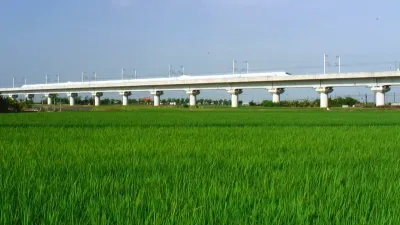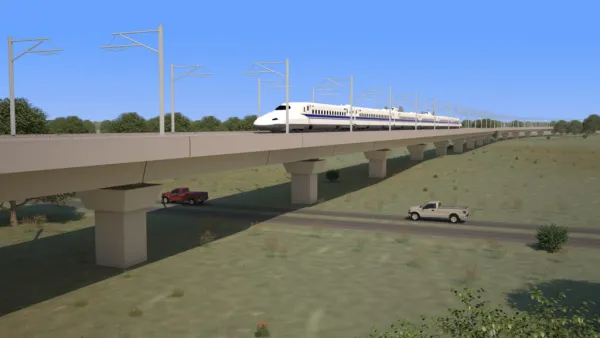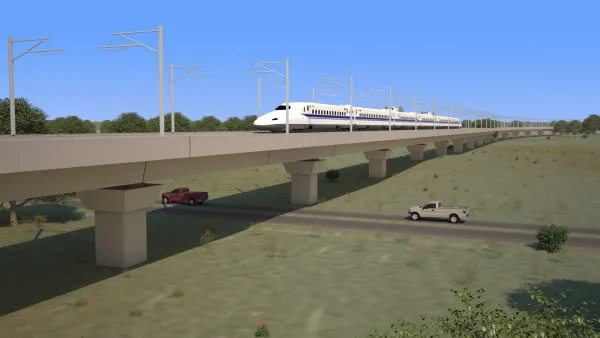Carlos Aguilar, Texas Central president and CEO, comments on the changes to the San Francisco-to-Anaheim project announced last month by California Gov. Gavin Newsom, and why his project linking Houston and Dallas/Fort Worth will progress.

"We fully understand the complexities of the California High-Speed Rail (HSR) project and the drivers that have led to the Governor of California’s decision to limit the scope of that state’s HSR," writes Carlos Aguilar, a former senior vice president at the global engineering company CH2M Hill.
It is important to contrast both the physical facts that make our project different, as well as the government versus private approach to building such large-scale infrastructure.
Topographical challenges in California non-existent in Texas
"The main challenge ... is connecting the Central Valley to the main centers of population in the Bay Area and Los Angeles," continues Aguilar.
This is why the current range of expected cost in California is between $77 billion and $98 billion. Out of this figure, the tunnels required to link the valley to San Jose (Pacheco Pass) and Los Angeles (Tehachapi Mountains) collectively, could cost well over $20 billion with significant underground risk.
To put this in perspective, the potential cost of these tunnels alone, is more than the total projected cost of Texas Central’s 240-mile project to link Houston and North Texas.
According to Texas Central, "the train system will cost more than $12-billion to construct. This includes the tracks, viaducts, berms, maintenance facilities, power substations, and three passenger stations."
Texas bullet train will remove cars from Interstate 45
The trip from Dallas to Houston, with one intermediary stop in the Brazos Valley, will take only 90 minutes, much faster than an auto trip today, let alone the future.
"Nearly 50,000 Texans travel between the two metropolitan areas at least once a week, 90% of them by car," writes Keith Barrow for Railway Age.
The current journey time by road ranges from 3.5 to 5.5 hours, and traffic has increased nearly 10% annually since 2012. A Texas Department of Transportation study estimates journey times could reach 6.5 hours by 2035, even with the additional capacity provided by planned highway enhancements.
Why Texas?
To paraphrase James Carville, "it's the jobs, stupid."
"After reviewing over 90 pairs of cities to determine the most commercially successful place to deploy a high-speed train, Houston to Dallas was the answer," writes Aguilar.
The Houston to Dallas/Fort Worth region is by far, the most rapidly growing region in the nation. In 2018, Dallas and Houston combined added 224,700 jobs, compared to number two city, New York, at 115,500 jobs. No other region even comes close.
At the right distance, with the right economic links between Dallas, Houston and the Brazos Valley, and without the complexities now evident in California, our approach is more financially feasible.
Private, not public approach to financing
The California project was launched in 2008 with a nearly $10 billion bond measure, and has received federal funding of $3.5 billion that President Trump, in light of Newsom's Feb. 12 announcement, wants to recoup. Additional funding has come from the state's cap-and-trade program.
In contrast, the Texas high-speed rail train is funded by "investors and entrepreneurs," according to the FAQ.
Texas Central is an investor-funded company utilizing a market-led approach to financing, led by a group of primarily Texan investors. The Railroad will not seek grants from the US Government or the State of Texas, nor any operational subsidy once operation begins. The project will be financed with a blend of debt and equity.
"We are confident the Texas line will provide the ridership to sustain the operations, repay the debt and provide a return to the investors," concludes Aguilar.
Construction is scheduled to start late this year.
FULL STORY: The Difference in the Texas and California HSR projects

Analysis: Cybertruck Fatality Rate Far Exceeds That of Ford Pinto
The Tesla Cybertruck was recalled seven times last year.

National Parks Layoffs Will Cause Communities to Lose Billions
Thousands of essential park workers were laid off this week, just before the busy spring break season.

Retro-silient?: America’s First “Eco-burb,” The Woodlands Turns 50
A master-planned community north of Houston offers lessons on green infrastructure and resilient design, but falls short of its founder’s lofty affordability and walkability goals.

Test News Post 1
This is a summary

Analysis: Cybertruck Fatality Rate Far Exceeds That of Ford Pinto
The Tesla Cybertruck was recalled seven times last year.

Test News Headline 46
Test for the image on the front page.
Urban Design for Planners 1: Software Tools
This six-course series explores essential urban design concepts using open source software and equips planners with the tools they need to participate fully in the urban design process.
Planning for Universal Design
Learn the tools for implementing Universal Design in planning regulations.
EMC Planning Group, Inc.
Planetizen
Planetizen
Mpact (formerly Rail~Volution)
Great Falls Development Authority, Inc.
HUDs Office of Policy Development and Research
NYU Wagner Graduate School of Public Service



























